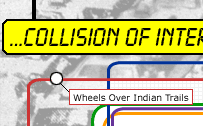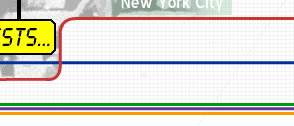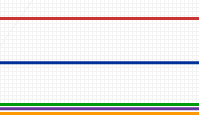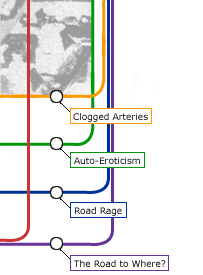



Situationist Theses on Traffic || The Social Ideology of the Motorcar || Killed by Automobile || Excess
How Traffic Destroys the Eco-City
by David Engwicht
The Growing Zone-of-Influence
Cars not only take over the space they need for moving, they also have a zone-of-influence which expands as speed and quantity of traffic increases. This means that the car not only demands that exchange space be converted to road or parking space, it also reduces or destroys the effectiveness of exchange space.
In 1970, Donald Appleyard conducted a very interesting study in San Francisco. He chose three residential streets which, on the surface, looked alike but which had different levels of traffic. He then carried out one hour interviews with 12 residents from each block, conducted as a survey on what it was like to live on their street and seeking suggestions for improvement. Residents were not told that Appleyard's primary interest was the effects of traffic on neighborhood life. Appleyard supplemented the questionnaire with detailed observations and mapping of activities in each street.
The first street carried 2,000 vehicles per day and was referred to in the study as Light street. The second carried 8,000 vehicles per day and was called Medium street. The third carried 16,000 vehicles per day and was called Heavy street. Appleyard asked the residents to indicate where friends and acquaintances lived on a map of their street. The results showed that those on Light street had three more friends and twice as many acquaintances as the people on Heavy street.
He also asked them to draw on the map of their street the area they considered to be their 'home territory'. Fig. 5 shows the 12 responses from each street combined into the one map. It becomes immediately obvious that as that as traffic volume increases, the space people considered to be their territory shrank.
The results from these two sections of his surveys are totally interrelated. People on Heavy street had less friends and acquaintances precisely because there was less home territory (exchange space) in which to interact socially. As one person from Medium street said about the increasing traffic, 'It used to be friendly; what was outside has now withdrawn into the buildings...'. Appleyard commented on his findings:
There was a marked difference in the way these three were seen and used, especially by the young and the elderly.Light street was a closely knit community whose residents made full use of their street. The street had been divided into different use zones by the residents. Front steps were used for sitting and chatting, sidewalks for children playing, and for adults to stand and pass the time of day, especially around the corner store, and the roadway by children and teenagers for more active games like football. However the street was seen as a whole and no part was out of bounds. Heavy street, on the other hand, had little or no sidewalk activity and was used solely as a corridor between the sanctuary of individual homes and the outside world. Residents kept very much to themselves. There was no feeling of community at all. Medium street again seemed to fall somewhere between the two extremes. It was still quite an activity was confined to the sidewalks where a finely sensed boundary separated pedestrians from traffic.
Appleyard concluded his study:
The contrast between the two streets [Heavy and Light] was striking. On the one hand alienation, on the other friendliness and involvement.
This increase in zone-of-influence and shrinking of home territory is insidious and goes through distinctive stages. First to be subjugated is the actual carriageway. In Appleyard's account above it can be seen that on Light street the people still considered the carriageway to be part of their home territory. It was still a place for children to play and where people gathered to talk. But in Medium street, residents had lost control of the carriageway and felt confined to the footpath.
This subjugation of the carriageway involves a transfer of ownership. The traditional users (children and residents) lose ownership and the motorist takes ownership. Thus motorists view pedestrians, cyclists or children playing in the street as intruding into their space. Studies by Professor Stina Sandels show that as the speed of traffic increases, the attitude of motorists to pedestrians becomes increasingly ruthless. Wide stretches of bitumen and fast flowing lanes of traffic reinforce drivers' perceptions that the street is their territory. An actual transfer of control or ownership takes place and this results in a shrinkage of people's home territory. Whether this transference of ownership is right or wrong will be examined later.
The next piece of the home territory to go is the footpath itself. As Appleyard observed, on Heavy street there was 'little or no sidewalk activity and [the sidewalk] was used solely as a corridor between the sanctuary of individual homes and the outside world'. This loss of ownership is in part do to noise, dirt and vibration caused by the traffic. But it is also a result of the disappearance of people. When the children no longer play in the street and people drive instead of walk, then even the footpath becomes a barren no-man's land and the street loses its main attraction- people.
However, this shrinking of home territory does not stop at the front fence. Appleyard observed a dramatic drop-off in gardening or people simply sitting on their front steps on Heavy street. Thus traffic eventually claims even the front yard. But the take over does not stop at the front door of the house. As one respondent from Heavy street said to Appleyard when asked to indicate his home territory; 'Just this apartment... not even that'. As traffic increases in their street numerous people are forced to abandon the front rooms of their homes because of the noise. Part, or in some cases the whole, of their home was lost as home territory.
The last step in this saga of shrinking home territory is that people abandon their homes completely and become traffic refugees. Appleyard observed that on Heavy street there were far fewer children than on Light street. 'The lack of children,' according to Appleyard, 'partly explained the impoverished social life on Heavy street; in fact many treated the street more as a transient hotel than as a residence'. Those families who could, had fled. On Medium street these processes were also at work. As the traffic slowly increased, families were in the course of leaving. Those who remain expressed deep regrets at the demise of their street community.
It may be argued that those who replaced the families who fled are the kind of people who do not mind traffic noise and who do not want neighborly relationships with others in their street. This ignores the plight of the families who at one time enjoyed a strong neighborhood community and have now been forced to flee. For them, long-term meaningful relationships have been fractured.
It also ignores the plight of those who are unable to flee the threat; those who are elderly, disabled or those who simply cannot afford to relocate. As Appleyard says, 'These "trapped" residents may suffer more than any others'. They must suffer not only the lifelong friends flee, but also the ongoing intrusion of traffic into their living rooms. Worst of all, they are condemned to a permanent poverty of relationships because there is absolutely no hope of resurrecting or re-creating the sense of community they once enjoyed.
The argument that the kind of people who move in are not bothered by noise and not interested in relationships also ignores one other factor: these people may discover a rich dimension of life they never new existed if they were to become part of a vibrant, caring neighborhood. Perhaps they are being robed of something they do not even know they need. However, I suspect the real reason these people locate on heavy traffic streets is more to do with economic imperatives than desire or lack of desire for neighborhood life. They simply cannot afford to but or rent elsewhere. For these people a lack of neighborhood friendship links is just one more cost they must pay for their poor economic situation.
This take over of home territory (the primary space for spontaneous exchange) by traffic cannot be measured simply by looking at how much of a city has been transformed to road space. Subjugation is a subtle process unrecognized by most city planners. It was this process that provoked a resident to tell a consultant, 'I don't care what your predictions for future traffic growth are. Just give us back some of the quality of life we enjoyed 15 years ago'.
Appleyard's research is backed by much anecdotal evidence, such as the elderly lady I met on my first door knock along Route 20. She had not ventured outside here front door for three months and I had to yell at here through the security door, not because she was deaf, but because of the noise coming from the road outside. For this lady, times had changed. The world outside her front door had become so hostile, she no longer felt safe outside the walls of her home. She felt her house was under siege from traffic.
A man told how once he and his wife had a number of friends on the other side of their street. A couple of years previously their street was widened to four lanes and immediately there was a dramatic increase in traffic. Because of the increase in traffic, he and his wife no longer felt safe crossing the road and had to stop visiting their friends. The friendships had died.
Another resident told how the neighbors in his street, in times past, had regularly gathered together for a street barbecue. As the traffic increased, these street activities decreased. But a strange thing happened. Large road works at the entrance of their street resulted in a dramatic drop in traffic on their street for a period of about six months. The result? A resurrection of many old neighborhood links and an increase of children playing in the street.
As home territory shrinks so does the opportunity for social interaction and spontaneous exchange. Hostile territory is not the place where people hold intimate conversations. Chuck Berry's prophetic words express, in another way, the results of the increasing zone-of-influence with its erosion of home territory and spontaneous exchange: loss of place.
Riding along in my automobile,
My baby beside me at the wheel,
Cruising and playing the radio,
And no particular place to go.
Burning the House to Stay Warm
Earlier I discussed how the introduction of the cane toads upset the delicate web of relationships. What I have been suggesting since is that the introduction of the car into the Eco-City unsettles a range of relationships and sets up chain reactions that feed on themselves. Cars compete for space and converting exchange space to movement space spreads the city which demands more travel which demands more space. Similarly, car traffic erodes home territory and the opportunity for spontaneous exchange. To make up for these lost exchanges, additional trips must be made which in turn further erodes home territory and spontaneous exchange.
As well, increased road infrastructure encourages inefficiencies such as cross-commuting, which puts more traffic on the roads, which demands bigger roads which encourages further inefficiencies. But the domination of the car also sets up numerous other feedback loops.
Increase in Trip Frequencies
New and upgraded roads encourage people to increase the frequency of trips. Instead of visiting Aunt Meg once a fortnight they now visit once a week. Again this seems like a benefit until we realize two things. Firstly, in a more compact city (a city which has turned over less of its living space to road space) Aunt Meg may be living just around the corner or within walking distance. Secondly, the illusion of greater accessibility to Aunt Meg may not only encourage an increase in frequency of visits; it may also increase a decrease in the length of visits. In the old days it may have taken three hours traveling by horse and cart to visit Aunt Meg. But visitors stayed the whole day. Today people spend 45 minutes traveling, but only stay for 30 minutes. In other words, greater road infrastructure promotes a pattern of living which actually increases the time spent travelling as opposed to enjoying the reason for which the trip was made.
Decreased Viability of Public Transport
The more spread-out a city becomes, the less viable its public transport. Instead of the bus travelling one kilometer to pick up ten passengers, it has to drive ten kilometers. Rail, light rail and underground rail are even more uneconomical in a spread out city because of the very high capital costs of providing the tracks in the first place. New roads also lure customers away from public transport, further eroding its viability. As the public transport system runs down, more people are forced to switch to private cars to maintain their previous levels of access to exchange opportunities.
Moving of Destinations Outside Walk and Cycle Range
As the city spreads an increasing number of destinations are moved outside of the cycle and walking range. Once a person switches to a private car for these trips, they then lose a range of spontaneous exchange opportunities which must be compensated for by more trips.
Erosion of Walk and Cycle Space
In some cases footpaths are narrowed or disappear completely. In other cases the footpath 'feels' unsafe because of proximity and speed of the traffic. One of the little understood effects of this is on the use of public transport. Almost every public transport trip starts with a walk or cycle journey. If it is too dangerous to cross a road to a bus stop, people, if they have the option, will often opt to drive their car.
Erosion of more benign means of transport is a good example of how these feedback cycles work. For example, many parents drive their children to school because it is too dangerous for them to walk or cycle; hence, they add to the very problem they are trying to overcome. In turn, other parents are then forced to drive their children.
Death of the Corner Store
The reasons why increasing road infrastructure kills off the neighborhood store and local shopping center are many:
Neighborhood stores are usually on the busiest roads and therefore are often the first victims of road widening.The building of wide roads to large regional shopping complexes has encouraged people to shop at national/ multinational chains thus eroding the viability of neighborhood stores.
As traffic increases in front of the store, the store comes into the zone-of-influence and thus becomes hostile territory, losing its charm as socializing space.
The conversion of homes to road space means a decrease in the number of patrons for the store, thereby eroding its viability. As a store closes or becomes unviable, local employment decreases which further decreases the number of customers working and living in the area, making other stores less viable. The dominoes fall one by one.
Death of the neighborhood store makes a surprising contribution to a reduction in social contact. It is not just the contact with the store owner, a valuable social contact in its own right, which is lost. Casual contacts which occur spontaneously on the way to the store are also lost. The end result is people are removed from the streets, further adding to the sense that the streets have been abandoned and handed over to traffic and no longer belong to the neighborhood.
I remember standing and studying the community life of a traffic calmed street corner in Cologne. The street had been modified to slow traffic to walking speed and the intersection had been significantly narrowed. On the corner was a neighborhood store, some houses, a post with a brass sculptured hat and some interesting wrought-iron work for people to park their bikes against. The intersection was paved and landscaped. You could feel the neighborliness just by standing and watching. A four year old girl arrived on her tricycle, riding on the roadway, with her grand father walking beside her. They stopped and talked for 20 minutes to the shopkeeper. I could not help wondering what would have happened to this level of community interaction if, instead of narrowing the roadway, authorities had followed the Los Angeles pattern by pulling the shop down and widening the intersection.
The death of the corner store is one of the factors in what sociologists call 'urban blight', a cancer that slowly eats its way through an entire neighborhood.
Back to top